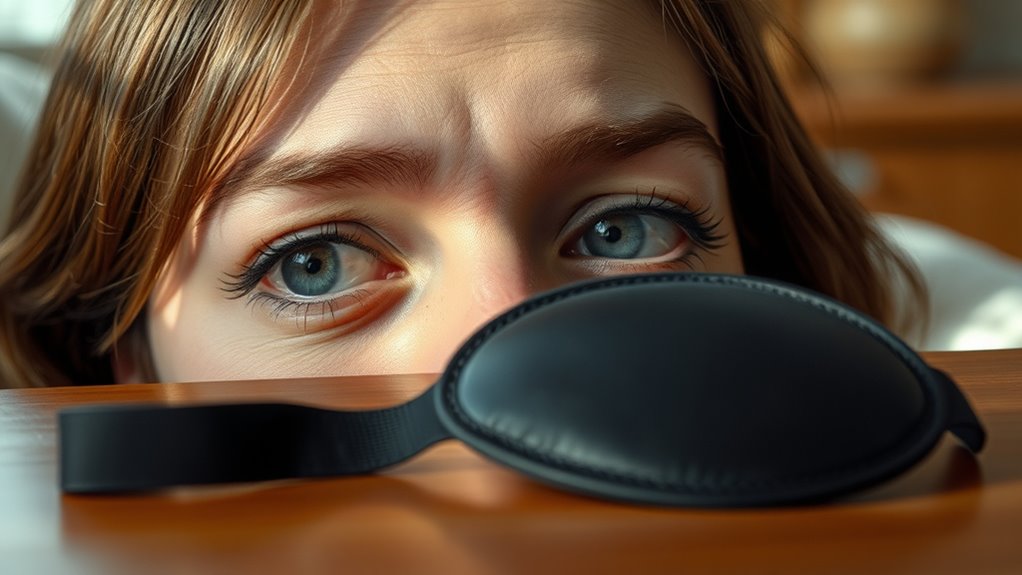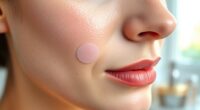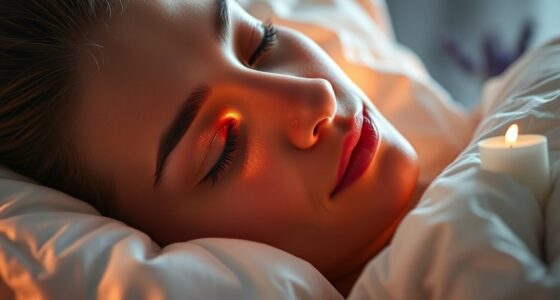Your eyes might feel tired due to prolonged screen time, blue light exposure, and even poor posture. These factors can lead to dryness, strain, and blurred vision. Symptoms like heavy eyelids and difficulty focusing could signal eye fatigue. Taking regular breaks is essential. Notably, eye patches can be a potential solution for some vision issues. They help strengthen the eye while offering protection. Discover more ways to counteract fatigue and improve your eye health.
Key Takeaways
- Prolonged screen time and blue light exposure lead to eye strain and fatigue due to constant focus and reduced blinking.
- Symptoms of tired eyes include blurred vision, heavy eyelids, dryness, and muscle spasms indicating visual stress.
- Environmental factors like poor lighting and dry air can exacerbate feelings of eye tiredness.
- Regular breaks, such as the “20-20-20 rule,” and adequate sleep are essential for relieving eye fatigue.
- Eye patches can be used to occlude one eye, aiding in vision recovery and reducing strain on the other eye.
Common Causes of Eye Tiredness

When you spend long hours in front of digital screens, you might notice your eyes feeling tired and strained. Prolonged screen time forces your eyes to constantly focus and refocus, leading to fatigue. The blue light emitted by devices can contribute to this strain, while unmanaged screen glare further exacerbates discomfort. You may also find that reduced blinking during screen use causes dry eyes, adding to your irritation. Environmental factors, like poor lighting and dry air, can intensify the tiredness. Additionally, if you have uncorrected vision issues or poor posture, you’re likely straining your eyes even more. Recognizing these common causes can help you take proactive steps to alleviate your discomfort, especially since digital eye strain from prolonged screen time is a significant contributor to overall eye fatigue.
Recognizing the Symptoms of Eye Strain

After identifying the common causes of eye tiredness, it’s important to recognize the symptoms that indicate you might be experiencing eye strain.
You may notice your eyelids feeling tired, aching, or heavy. Blurred vision and difficulty focusing can also signal that your eyes are overworked. If you’re experiencing red, watery, or irritated eyes, that’s another red flag. Muscle spasms in your eye or eyelid can indicate stress on your visual system. Additionally, you might find it hard to keep your eyes open, especially after long periods of screen time or intense focus. Prolonged focus on screens can significantly contribute to these symptoms, making it essential to recognize them early to take steps to alleviate discomfort and improve your overall eye health.
The Role of Blue Light in Eye Fatigue

Blue light, emitted by digital screens, penetrates through your cornea and lens, reaching the retina. This exposure can lead to uncomfortable symptoms like eye strain, dryness, headaches, and blurred vision. If you spend long hours in front of screens, you might find that your eyes feel increasingly fatigued. Additionally, prolonged screen time can exacerbate these symptoms, as it leads to excessive eye strain. Furthermore, blue light exposure in the evening disrupts your melatonin production, affecting your sleep quality. As you age, your eyes become more sensitive to blue light, making it essential to be mindful of your screen time and consider using blue light blocking glasses. Protecting your eyes can help reduce fatigue and improve your overall well-being.
Importance of Rest and Breaks for Eye Health

Blue light exposure from screens isn’t the only factor that can lead to tired eyes; taking regular breaks and ensuring you get enough rest are crucial for maintaining eye health. Sleep is essential for keeping your eyes hydrated and producing necessary fluids. When you skimp on sleep, you might notice dry, irritated eyes due to less tear production. Sufficient sleep helps alleviate eye strain from daily activities, allowing your eyes to recover and function optimally. Regular breaks from screens help alleviate eye strain, giving your eyes time to relax. Try the “20-20-20 rule”—look away every 20 minutes. Sticking to a consistent sleep schedule can also support your eye health, allowing for significant repair processes. Additionally, embracing relaxation techniques before bedtime can enhance the quality of your sleep, leading to better overall eye health.
Exploring the Eye Patch as a Potential Solution

While many people associate eye patches with children, they can also serve as a practical solution for adults facing various vision issues. Eye patches can help treat conditions like amblyopia and double vision by occluding one eye, allowing the other to strengthen or improve binocular vision. They are commonly used post-eye procedures and are non-invasive and inexpensive, making them an appealing option. Post-surgery, eye patches protect and aid healing, while different types, like adhesive patches or eye shields, cater to specific needs.
Although effectiveness varies, especially in adults, combining patch use with other treatments can enhance results. However, it’s essential to seek regular medical supervision to avoid potential complications and guarantee ideal recovery while wearing an eye patch.
Frequently Asked Questions
Can Eye Tiredness Affect Overall Health and Productivity?
Yes, eye tiredness can greatly affect your overall health and productivity.
When your eyes are strained, you may experience discomfort that leads to decreased focus and increased mistakes at work. This can ultimately reduce your productivity by up to 20 percent.
Additionally, fatigue from eye strain can contribute to headaches and musculoskeletal issues, impacting your overall well-being.
Taking care of your eyes is essential for maintaining both your health and work performance.
How Do Stress and Anxiety Contribute to Eye Fatigue?
Stress and anxiety can really take a toll on your eyes. When you’re stressed, muscle tension builds around your eyes, causing strain and discomfort. You might even experience eye twitching or blurred vision as your focusing muscles struggle to keep up.
Additionally, heightened stress can lead to dry eyes and fatigue, making it hard to concentrate. By managing your stress levels, you can help alleviate these symptoms and improve your overall eye comfort.
Are There Specific Foods That Help Reduce Eye Strain?
Did you know that nearly 70% of adults experience eye strain due to prolonged screen time?
To combat this, you can incorporate specific foods into your diet. Leafy greens like spinach and kale are packed with lutein, while fish like salmon provides omega-3 fatty acids.
Nuts and seeds offer vitamin E, which protects your eyes. Staying hydrated and eating a balanced diet will help you reduce eye strain effectively.
What Role Does Age Play in Eye Fatigue?
As you age, your eyes undergo several physiological changes that can contribute to fatigue.
The lens becomes less flexible, making it harder for you to focus. You might notice decreased muscle activity in your eyes, which limits your ability to adjust focus.
Also, cognitive effort increases with age, straining your eyes further during tasks.
Managing screen time and taking regular breaks can help alleviate some of this fatigue as you navigate these changes.
How Can Lifestyle Changes Improve Eye Health?
You can boost your eye health by eating right, exercising regularly, and adopting healthier habits.
Incorporate omega-3-rich foods, leafy greens, and colorful fruits into your diet. Engage in 30 minutes of moderate exercise daily to lower the risk of vision problems.
Quit smoking, limit alcohol, and practice good sleep hygiene to reduce fatigue.
Finally, protect your eyes with sunglasses and take regular breaks from screens to keep them feeling fresh and sharp.
Conclusion
In today’s fast-paced world, your eyes often bear the brunt of constant screens and stress. By recognizing the symptoms of eye strain and taking regular breaks, you can rejuvenate your vision. The eye patch, a simple yet effective remedy, acts like a soothing balm for weary eyes, allowing them to rest and recover. Remember, just as a flower needs sunlight to bloom, your eyes need care to shine bright. Prioritize your eye health; they deserve it!










